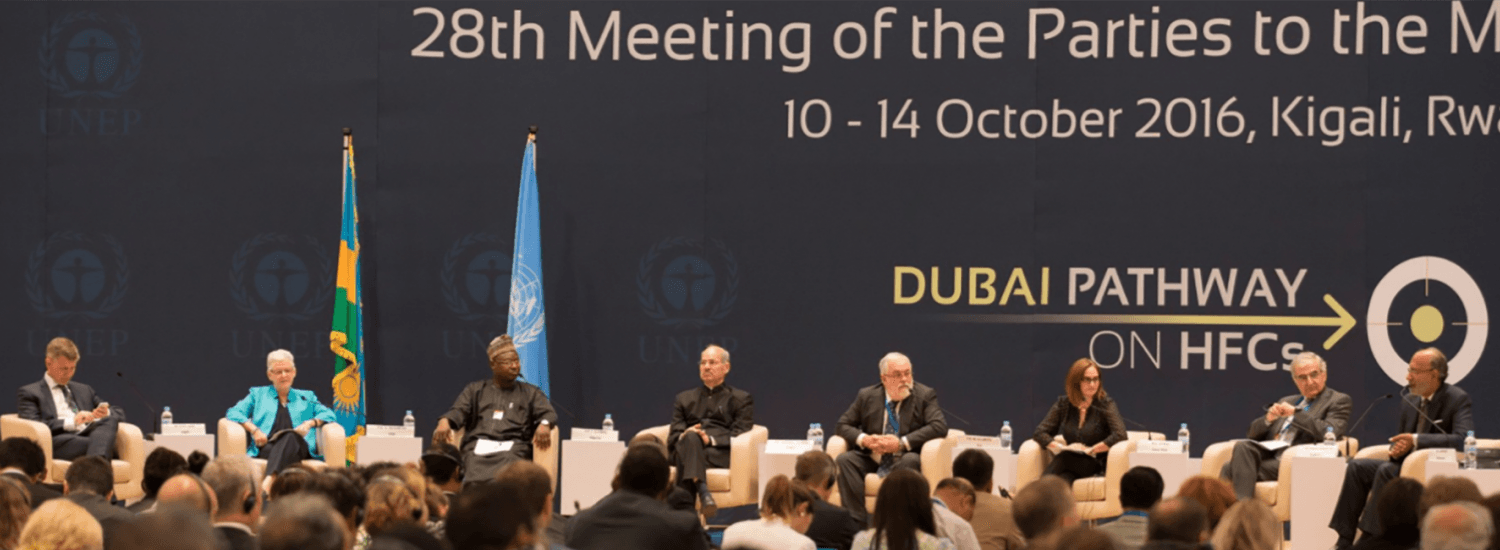Ozone Treaty Taking a Bite Out of US Greenhouse Gas Emissions

The Montreal Protocol, the international treaty adopted initially to protect and ultimately to heal Earth’s protective ozone layer, has significantly reduced emissions of ozone-depleting chemicals from the United States. But in a twist, a new study by NOAA and CIRES scientists shows the 30-year old treaty has also significantly reduced climate-altering greenhouse gas emissions from the United States.
That’s because the ozone-depleting substances controlled by the treaty are also potent greenhouse gases, with heat-trapping abilities up to 10,000 times greater than carbon dioxide over 100 years.
The new research, the first to quantify the impact of the Montreal Protocol on U.S. greenhouse gas emissions with atmospheric observations, shows that reducing the use of ozone-depleting substances from 2008 to 2014 eliminated the equivalent of 170 million tons of carbon dioxide (CO2) emissions each year. That’s roughly 50 percent of the reductions achieved by the United States for CO2 and other greenhouse gases over the same period. The study was published today in Geophysical Research Letters.
An aircraft pulls samples from the atmosphere as part of NOAA's atmospheric monitoring network. Photo: Sonja Wolter/CIRES and NOAA
“We were surprised by the size of the decline, especially compared with other greenhouse gases,” said lead author Lei Hu, a CIRES scientist working at NOAA.
Hu added that the benefits of the Montreal Protocol on GHG emissions will likely grow in the future. By 2025, she projects that the effect of the Montreal Protocol will be to reduce U.S. greenhouse gas emissions by the equivalent of 500 million tons of CO2 per year compared with 2005 levels. This reduction would amount to about 25-30 percent of the U.S. target committed to during the United Nations Paris climate meetings in 2015 (Council of Parties or COP 21).
“Most of these reductions will be in addition to what is achieved by COP21 because ozone-depleting substances are not included in COP21 targets,” she said.
Previous studies have demonstrated that the Montreal Protocol has been more effective at curtailing global greenhouse gas emissions than any other international effort, even though climate change was not a consideration during the initial treaty negotiations in the late 1980s.
Guus Velders, a scientist with the Netherlands Assessment Agency who described the Montreal Protocol’s climate benefit in 2007, said the new study “convincingly shows that the Montreal Protocol continues to be a powerful instrument to reduce greenhouse gas emissions and thereby contribute to fight climate change.”
“The fact that these results are based on emissions derived from atmospheric observations is very powerful,” he added.
The analysis, based on data collected by NOAA’s atmospheric monitoring network, confirms that the Montreal Protocol has been highly successful in the United States in its primary goal—reducing emissions of manufactured chlorine-based chemicals that, in addition to depleting ozone world-wide, create a hole the size of the continental United States in the Earth’s protective ozone layer over the Antarctic each September and October.
Those chemicals—chlorofluorocarbons (CFCs) and hydrochlorofluorocarbons (HCFCs), and their substitutes, the hydrofluorocarbons (HFCs)—have been widely used as refrigerants, foam blowing agents, aerosol propellants, fire retardants, and solvents. Chlorine from CFCs was first identified as capable of destroying stratospheric ozone in 1974. The production and consumption of these chemicals has been controlled by the Montreal Protocol since the late 1980s.
Implementation of the Montreal Protocol in the United States, largely through the Clean Air Act, led to a near complete phase-out of U.S. production and consumption of chlorofluorocarbons (CFCs) beginning in 1996 and a 95 percent decline of hydrochlorofluorocarbons (HCFCs) production since 1998.
As a result, total emissions of CFCs in the U.S. have decreased by two-thirds from 2008 to 2014, while emissions of HCFCs declined by about half.
Some chemicals that damage Earth's ozone layer—categorized here as CFCs and HCFCs—are also potent greenhouse gases, so a treaty to reduce the damage they do to the ozone layer has also prevented a measurable amount of greenhouse emissions. These figures show declining U.S. emissions of the ozone-depleting chemicals, in units of carbon-dioxide-equivalent effects. For example, CFC emissions have dropped in the last 6 years by an amount equivalent to a 0.1-gigaton (100-million-ton) reduction of CO2 emissions per year. Image: NOAA/CIRES
Another indication of the treaty’s impact is increasing U.S. emissions of ozone-friendly chemicals, such as hydrofluorocarbons or HFCs. However, some HFCs are also potent greenhouse gases, and their increased use is offsetting some of the climate benefit of the Montreal Protocol, said NOAA’s Stephen Montzka, a co-author.
Countries adhering to the Protocol, including the United States, agreed to limit future production and consumption of HFCs in 2016.
"This shows what can be achieved by concerted and thoughtful international and U.S. policy efforts," co-author Scott Lehman of the Institute of Arctic and Alpine Research at the University of Colorado Boulder. "While any reductions in emissions of greenhouse gases are beneficial and welcomed, it needs to be emphasized that the long-term climate problem remains almost entirely a carbon dioxide problem. So, if we wish to reduce the risk of dangerous climate and environmental outcomes, we’ll need to focus on substantially reducing emissions of carbon dioxide.”